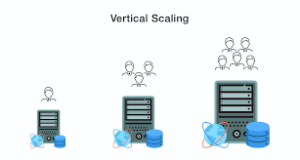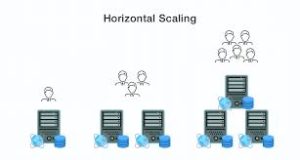For today’s generation, requests for applications capable of managing relentlessness without questioning efficacy are even more eminent. Business applications are not any different and as businesses expand their horizons, their applications must expand limitlessly with the ever growing and extending customer base, tangible and intangible transactions and voluminous consequential data. At Jain Software, the focus is to construct applications that can fit the existing requirement as well as can be scaled up to cater the future requirements. In this blog, we will look at what scalability is and in general, the approaches employed by Jain Software as well as ways of ensuring applications are properly scaled.
Understanding Scalability
Scalability, therefore, signifies to which extent an application can increase resources that it consumes primarily in order to manage a higher load: processing power, memory or disk space. Scalability measures are the ability of a certain application to perform optimally while facing an increased quantity of work i’n relation to it. There are two primary types of scalability:
There are two primary types of scalability:
Vertical Scalability (Scaling Up): It is the act of enhancing the abilities of a single server, for instance, by adding more CPU, engaging more RAM, or extra storages. Although this can be quite useful to some extent, it is not very practical and may even prove costly at times.
Horizontal Scalability (Scaling Out): The second possible solution is adding even more servers or nodes to distribute the load more evenly. By doing this way it is generally cheaper and contains less fault and have better redundant control more than other way.
For such reasons, at Jain Software, we pay a special attention to creating the applications that will incorporate horizontal scalability into them in order to achieve high availability and reliable performance.
the Seven Scalability Principles for building scalable applications
1. Modular Architecture
A modular architecture involves a splitting of a given application into different modules or services, which by no means are dependent on each other. This approach which can be achieved through microservices means that every module of the application can be built independently, deployed and scaled when needed. That is why developers can maintain the application more efficiently and what is more important, scale it easily.
2. Efficient Database Design
Databases are centrally positioned as the core building block of any scalable application. Further, there are normalization, it can be defined as the act of reducing redundancy in the database, Indexing which is all about fast retrieval of data and partitioning which is all about distribution of data across different servers. We also consume NoSQL databases at Jain Software where needed and the strategy has been effective given that NoSQL databases are more beneficial for specific form of operations.
3. Load Balancing
Load balancing is a procedure of traffic distribution that prevents any particular server from being overloaded with an unusually high volume of traffic. It also enhances the capacity in case of occasions when the servers may Let’s fail. As stated earlier, at Jain Software we use complex load balancing algorithms for our applications.
4. Caching
Caching is the use of memory to store information that is often required to be retrieved so that repeated use of the database helps to slow down the traffic and speed up the retrieval process. A cached object is created using cachedObj = Cache. GetNewCacheDependency( ) and is invalidated using cachedObj = new CacheDependency( ). Additional measures that need to be implemented include caching mechanisms which include in-memory caches (e. g. By leveraging presence of modern day key distribution services like message broker systems (Redis) and content delivery networks (CDNs), we can easily improve the performance and capacity of our applications.
5. Asynchronous Processing
By working in a asynchronous manner, processing is carried out in the background, instead of occupying the single resource at a time. This is rather helpful especially when the operations under processing are large and cumbersome like uploading files, data analysis and API calls. Thus as is evidenced by the message queues example; e. g. If we have to use integrated systems (such as RabbitMQ, Kafka, etc. ), it will not affect the management of asynchronous tasks.
6. Statelessness
As for the statelessness, applications of this type do not preserve any session information across the requests. It provides a way to scale horizontally because any given server can respond to any client request without having to be informed of the prior interactions. Picking up from there, at Jain Software, we always ensure that our applications have as much states reduced to the barest minimum; commonly employing schemes such as the JSON Web Token.
7. Auto-Scaling
Auto-scaling allows the number of active servers to scale, meaning that it increases and decreases depending on the current load. This keeps the utilization of resources to the greatest degree, and the expenses to the lowest. To implement load balancing in our applications, there is the use of the cloud services such as AWS Auto Scaling and Azure Scale Sets.
Methodologies at Jain Software
Agile Development
Agile approaches provide for the ongoing evolution and improvement of the project through integrated, user-focused, and flexible processes. The software is developed at Jain Software complies to Agile practices of having the application scalable from base. Sprint cycles and scrum reviews help address potential scalability issues before they can become a problem, or make changes accordingly.
DevOps Practices
DevOps means development and operations in which the methodologies of both fields overlap to facilitate software delivery. DevOps incorporates CI/CD and also automated testing, which is key in improving the system. This not only accelerates the development, but also the level of quality and possibilities for subsequent expansion of our applications.
Cloud-Native Development
Developing applications torun on a cloud is all about maximizing the potential of the cloud to support theapplication. This includes microservices architecture, containerization (for example, using containers), serverless computing, artificial intelligence and machine learning. g. Limitations Heterogeneous environment: Extensive use of open source solutions (e. g. Docker, Kubernetes), and maintaining managed services (e. g. There are a number of distributed platforms for hosting code, such as AWS Lambda, Azure Functions). Focusing on developing absolutely cloud-native software services, Jain Software achieves scalability and redundancy for applications and their deployment.
In its endeavor to achieve scalability, Jain Software has to consider the following aspects.
Performance Testing
In this process it is necessary to evaluate potential load, or find out problems related to performance bottling. At Jain Software, we provide comprehensive performance testing services, such as load testing, stress testing, and endurance testing. All these stress tools like JMeter and Gatling are very useful in a way that they enable us to test different parameters and conditions to be certain that our applications are fit for the performances they are going to encounter.
Monitoring and Logging
The continual chewing and logging is something that was found to be crucial to ensure that the applications in large scale environments are sustainable. In the aspect of application performance and debugging, we employ Prometheus and Grafana to track performance issues and anomalous behaviors and explore the causes with the help of ELK Stack.
Continuous Improvement
WARDS imply that quality is not a one-time activity but a continuous process as is the case with scalability. In Jain Software, we are always striving to reach to the next level where we can improve ourselves. This may include condition checks, audits of the code by our quality assurance team, and user feedback that helps us find areas for improvement.
Case Studies
Case Study 1: The act of selling and purchasing goods and services through a computer and the internet is known as electronic commerce or e-commerce platform. One day, a leading e-commerce company sought help of Jain Software to develop an e commerce application possessing great flexibility so that era’s volumes of forex could be managed within it in a period of single event of huge sales and discounts. A microservices architecture helped us in organizing the application and using a distributed NoSQL database proved fruitful and integrating auto-scalability in the cloud saw us react to traffic changes appropriately. This led to an increased efficiency and general satisfaction amongst the user base of this particular system.
Case Study 2: As it has been established, the usage of the FinTech application is vast, ranging from the following areas of the finance industry: One example of a startup in this sector is a FinTech organization that required strong and efficient application platform to handle financial operations. To render jobs stateless, better protected through higher encryption, and balanced more efficiently, Jain Software created an application monitoring it in real time. The interactive application’s horizontal scalability made it possible for social networking sites to accommodate growing clients and transactions whilst maintaining secure stability.
Conclusion
In the contemporary world where consumers are demanding and sizes of data output are increasing, it is crucial to build apps that can be scaled. At Jain Software, the various pratitional techniques which are used to follow the principles of scaling includes, modularity of the application, scientific database optimization, load symmetry, caching and many more. From values like Agile development, Dev Ops and cloud-native, we strive to make scalability an inherent aspect of the great software solutions we offer. Using performance tun performance tests, constant evaluation and an understanding that performance is not a destination but a journey, we guarantee that not only are our applications capable modern loads but they are ready for any increase in the future loads.
When allowing your business to work with Jain Software, you can be sure that applications would be able to handle even the largest loads that could be thrown at them while ensuring the best possible performance and stability. Being new or an experienced company we have the knowledge and skills to assist in ensuring that our applications are manageable for continuous progress.
If you are now eager to maximize your application, then do not hesitate to call Jain Software now and allow us to start constructing the stronger form of application that is now needed within the society.

